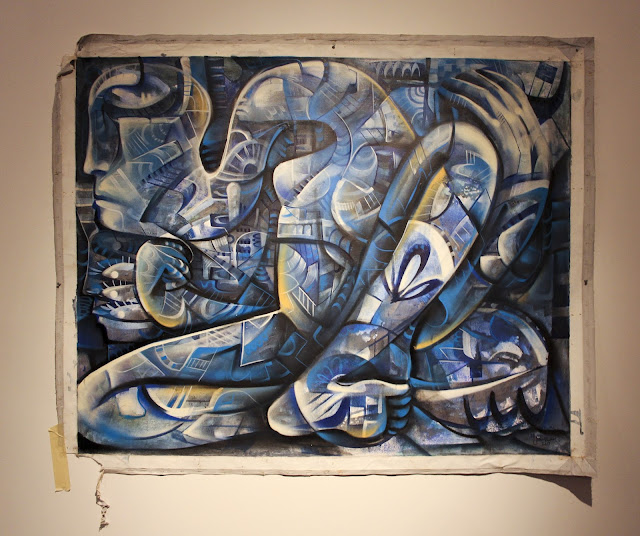CΔCHING OUT @ Beatnik Studios
“These works are a study in finding forms in this flux,
submitting to the work to reveal different paths and choosing one.”
-Artist, Shaun Burner
There is something to be said about the presence Shaun Burner brings to the Sacramento art scene. He contributes to the community in multiple ways, through his own gallery space at the Warehouse Artist Lofts called 1810 Gallery, through leading roles with M5Arts events like Art Hotel and ARTSTREET, and a professional career as an artist. Typically when one hears of works by Burner, they envision his murals and large scale works in public places; thus the recent solo exhibition, Forms in Flux, at Beatnik Studios provided a glimpse into Burner’s body of work in a gallery setting that consisted of twenty-eight paintings and showed the development of some new visual techniques. Forms in Flux had three distinctive styles: those reminiscent of his street art style, those which conveyed a narrative with figures, and a newer, more experimental form that consisted of a fluid black and white design with subtle images, which for our purposes we will refer to as the Rorschach style.
 |
| Hold and Break (pt. 2), Acrylic on Canvas |
The “List of Works” pages, provided by the gallery to dictate label information, noted that all of the twenty-eight works were completed in 2017. However, we found through examining the works that what appears to be Burner’s more mature, street art style have dates on the canvas which are signed 2013. These works, in particular, appear to be more fully developed with possible art historical references in the formal elements. For example, in Hold and Break the bulky, sinuous figure is rendered with a distinct black outline. For Post-Impressionists like Paul Gauguin and Vincent Van Gogh, this black outline technique was called cloisonnism, and served to separate the visual surface like stained glass. As seen in this work, Burner utilizes this technique to layer and blur the separation between background and foreground. The repetitive step-formations also appear to reference the infinite staircase landscapes of M.C. Escher, while the enlarged blue figure that engulfs the canvas is formed similarly to Tarsila Do Amaral. All of these formal elements and art historical references contribute to the fluid claustrophobia of the image, and make for a very stimulating work to experience that is noticeably similar to Burner's street art murals. Two other paintings, Time to Wake Up and Boy Stance, are in conversation with one another, and display luminescent bulky bodies consuming the canvas, with background and foreground as a merged mosaic. Yet, the figures are fully designed and contribute to the complexity of the overall image.
 |
| Left: Time to Wake Up, Right: Boy Stance |
It is natural for artists to experiment and develop their style, and understandably so! For if they do not grow, how can they stay relevant to the conversation of their time and place? Because we question the time sequencing of the body of work arranged in Forms in Flux, we follow this stylistic development through its gradual transition, until it is starkly different from his street style. A large scale painting on canvas entitled Repose continues to use the figure, but in a different way than the previous images. In Repose, the large scale figure doesn't wholly consume the canvas, but rather, cool tones bleed into warm tones as a titan-like figure rests contemplatively in the foreground with a city off in the distance. The narrative of this piece can be received more directly, and is distinctive as the transition between styles.
 |
| Repose Image provided by: Beatnik Studios |
 |
| Adrift Thoughts, Acrylic and Spray Paint on Panel |
 |
| Caring For My Best Friend, Acrylic and Spray Paint on Panel Image provided by: Beatnik Studios |
 |
| Out Like Lion, Acrylic and Spray Paint on Panel Image provided by: Beatnik Studios |
As always, Beatnik Studios has a fantastic space which can show a large body of work in a variety of ways. Because THE CΔCHE viewed this show by appointment on the weekend, we would like to note that we experienced the display literally in flux due to another event being set up. This may have contributed to our criticism of the works in Forms in Flux, since we did not view them in their specified, curated locations. However, we appreciate Burner's experimentation with form. As viewers we understand this was a large feat to include so many works into a solo exhibit, and look forward to the evolution of this new style.



Comments
Post a Comment